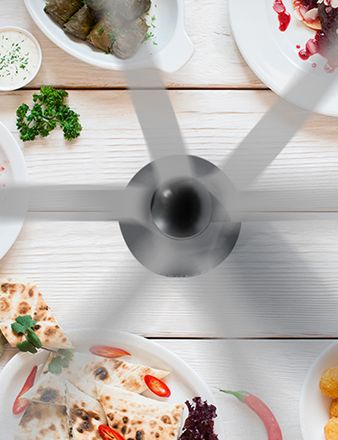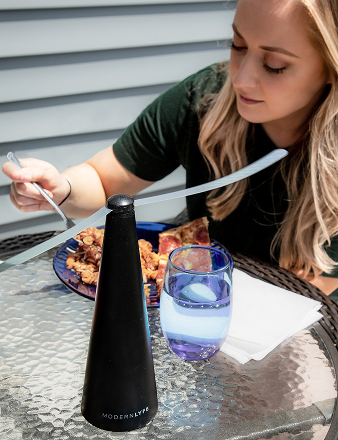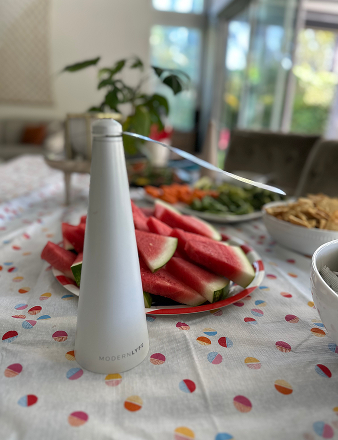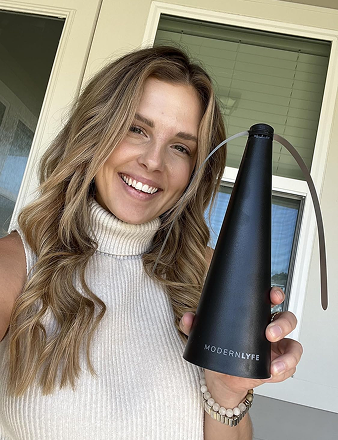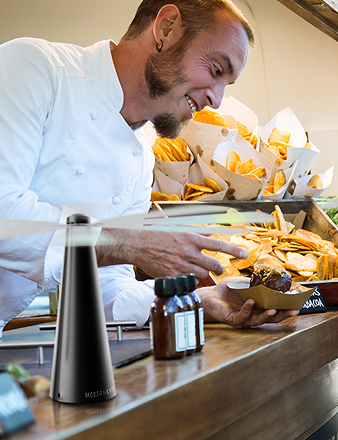An Off Repellent Fan is a simple, chemical-free gadget designed to keep flies away from your food. It uses soft, spinning blades with reflective patterns to create a gentle breeze and a visual disturbance that flies hate. This makes it a must-have for anyone who loves eating outdoors, from home patios and restaurant decks to large events.
Your Chemical-Free Solution to Outdoor Dining
You’ve set up the perfect backyard barbecue. The grill is sizzling, the drinks are cold, but a swarm of flies decides to crash the party. It's a common problem that can ruin a great meal. Instead of reaching for smelly sprays or chemical candles, there’s a smarter, cleaner solution.
An off repellent fan creates a simple, invisible barrier that flies instinctively avoid. It’s not magic—just a clever design that uses a fly’s natural instincts against it. People are catching on because it solves the fly problem without adding anything unpleasant to the atmosphere.
Why Go Chemical-Free?
Switching to a chemical-free solution like a repellent fan has major benefits. The most important one is safety. You can place the fan right in the middle of your food spread without worrying about sprays contaminating the meal or exposing kids and pets to harsh substances.
The beauty of a repellent fan is its simplicity. It works by disrupting a fly's senses—sight and touch—instead of using toxins or smells. That makes it a safe, elegant solution for any get-together centered around food.
This approach also preserves the taste and smell of your meal. Many traditional repellents have a strong, unpleasant odor that can overpower the aroma of your food. A fly fan is silent and odorless. The only thing you'll smell is what's on the grill.
Let’s break down the other benefits. These fans are:
- Eco-Friendly: With no chemical sprays, they're a much greener choice.
- Reusable & Cost-Effective: Buy it once and it works all season, unlike sprays or traps you have to keep replacing.
- Modern Design: Today's designs look sleek and blend seamlessly into your table setup.
Ultimately, these devices give you peace of mind. You can focus on enjoying your meal and your company in a comfortable, pest-free zone.
To give you a clearer picture, here's a quick breakdown of how these fans work.
Off Repellent Fan At a Glance
| Feature | How It Works | Primary Benefit |
|---|---|---|
| Soft, Spinning Blades | The constant motion creates a gentle air current that flies find difficult to fly through. | Creates a physical, yet harmless, barrier around your food. |
| Holographic/Reflective Patterns | Shiny patterns on the blades reflect light chaotically, scrambling a fly's vision and disorienting them. | Visually deters flies before they get close. |
| Chemical-Free Operation | The fan relies purely on motion and light, with no sprays, lotions, or toxins. | 100% safe to use around food, children, and pets. |
| Battery-Powered & Portable | Most models run on AA batteries, making them lightweight and easy to place anywhere without an outlet. | Ultimate convenience for patios, picnics, camping, and events. |
This table sums up why these fans are such an effective and popular choice for keeping your meals fly-free.
How Do These Fly Fans Actually Work?
A fly repellent fan looks simple, but its minimalist design is deceptive. It’s a clever device that uses a two-pronged, chemical-free attack on a fly's basic instincts.
First, the spinning blades create a physical barrier. The soft blades generate a gentle but consistent air current. For a small insect like a fly, navigating this is like trying to walk through a constant windstorm. This gentle breeze makes it difficult for flies to fly straight, land on your food, or even get close. It’s a simple "no-fly zone" that keeps them at a distance.
The Real Secret: Visual Disruption
Here’s where it gets interesting. The real magic isn't just the wind; it's the holographic patterns on the fan blades. These aren't just for decoration. They're designed to bend and refract light in a way that messes with a fly’s vision.
To understand why this is so effective, you need to see the world through a fly's eyes. Flies have compound eyes, which are made up of thousands of tiny lenses. This gives them a fragmented, mosaic-like view that is extremely sensitive to changes in light and movement.
The shimmering, ever-changing light from the holographic blades completely overwhelms a fly’s compound eyes. To the fly, this isn’t a neat light show; it’s a chaotic and threatening signal. Its brain registers "danger," and it instinctively flies away.
It's a brilliant optical illusion that flies are biologically wired to avoid. That’s the core of why these fans work so well.
This simple illustration shows how the fan creates a protected zone right where you need it most.
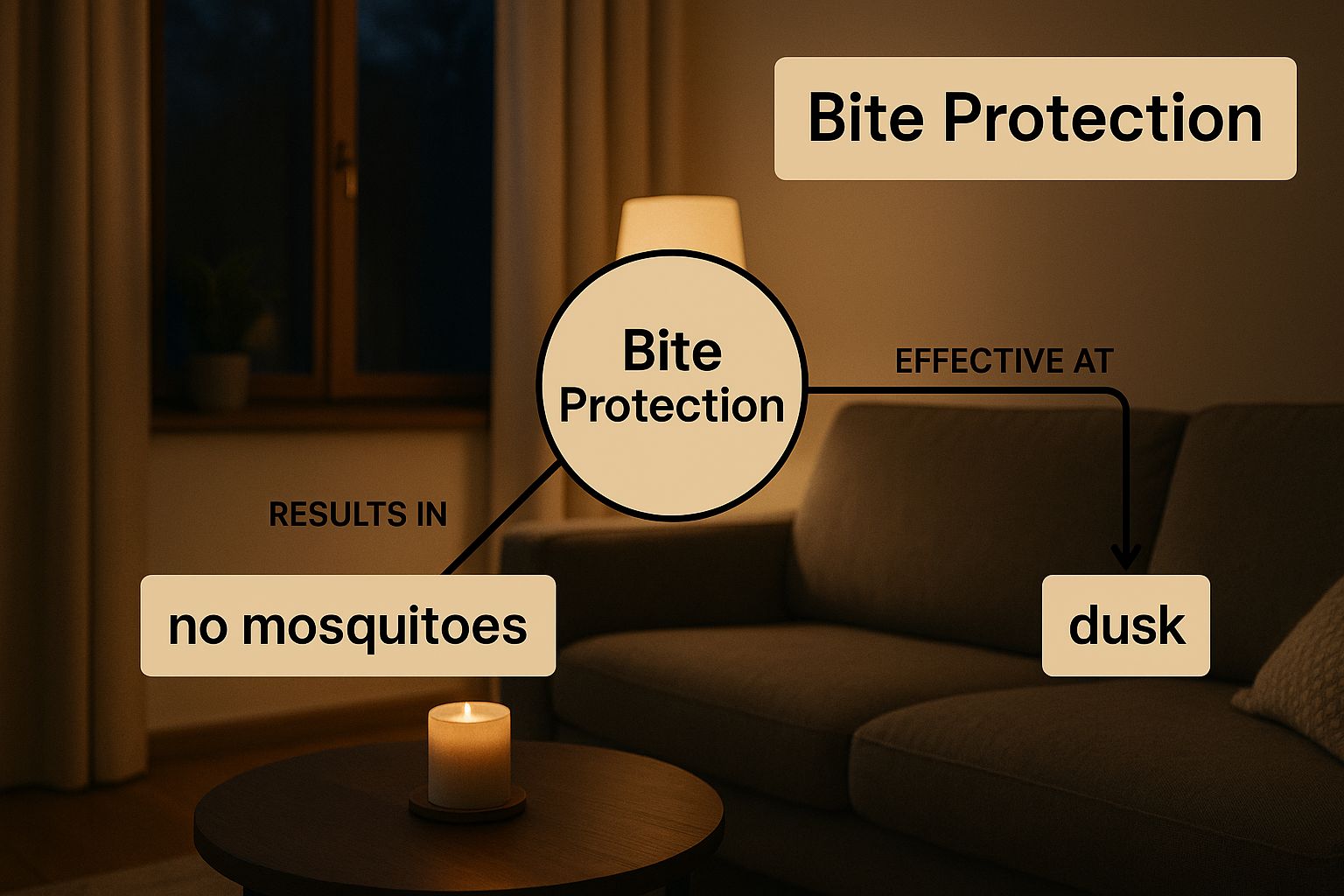
As you can see, it establishes a pest-free bubble, letting you enjoy your meal in peace without disrupting the atmosphere.
Why a Chemical-Free Solution Is a Big Deal
This science-backed approach is a welcome change from typical bug control methods. More and more, people are seeking alternatives to chemical sprays and lotions with ingredients they don't want near their food and family.
This shift is clear in market trends. The U.S. insect repellent market was valued at USD 376.9 million in 2024 and is projected to reach USD 540.6 million by 2030. People want safer solutions, and devices like the off-repellent fan are exactly what they're looking for.
This elegant bit of science provides a solid answer to the big question. If you want to explore the topic even more, check out our in-depth guide that asks do fly fans work. It’s a fantastic blend of physics and biology that creates a fly-free space without compromise.
What to Look for in a Great Repellent Fan
Not all fly repellent fans are created equal. While the concept is simple, a few key features separate the truly effective models from the rest. Knowing what to look for ensures you get a fan that actually keeps your meal pest-free.
The most important part? The blades. The best fans use soft, flexible blades with soft-stop technology. This is a critical safety feature. If a hand gets in the way while reaching for the salt, the fan stops instantly. It gives you complete peace of mind, especially with kids or pets around the table.
You'll also notice the shiny, holographic patterns on the blades. They aren't just for looks. These patterns disorient flies by scrambling light. Look for models with dense, complex patterns, as they create a more confusing visual field for a fly's compound eyes, making them more likely to buzz off.
Power Source and Portability
How you power the fan makes a huge difference in how and where you can use it. Your choice depends on your lifestyle and where you'll be battling bugs.
- Battery-Operated Models: These are the most versatile option. Usually powered by AA batteries, you can place them on a picnic blanket, a camping table, or anywhere far from an outlet.
- Plug-In or Rechargeable Models: For a more permanent solution on your back patio or at a restaurant, a plug-in or rechargeable model is ideal. They offer consistent power for hours, so you don't have to worry about swapping batteries mid-meal.
The right power source is about reliability. A fan that dies mid-meal is useless. Match the power type to your needs to ensure uninterrupted protection.
Durability and Performance Metrics
Beyond the basics, a few other things separate a great fan from a good one. Build quality is key. You'll be using this outdoors, so it needs a sturdy base and durable materials that won't fail after a few accidental bumps.
Another huge factor is the noise level. You want a peaceful meal, and a motor that sounds like a tiny airplane is as distracting as the flies themselves. The best repellent fans are whisper-quiet, doing their job without you even noticing they're on.
Finally, consider the coverage area. One fan typically creates a fly-free zone of about 2-3 feet in every direction, perfect for a small table for two to four people. For a long rectangular table or a buffet, you'll need a few fans to create an overlapping barrier and keep the entire area protected.
For a deeper look at specific models that nail these features, check out our guide on the best fly repellent fan.
Mastering Placement for a Fly-Free Zone
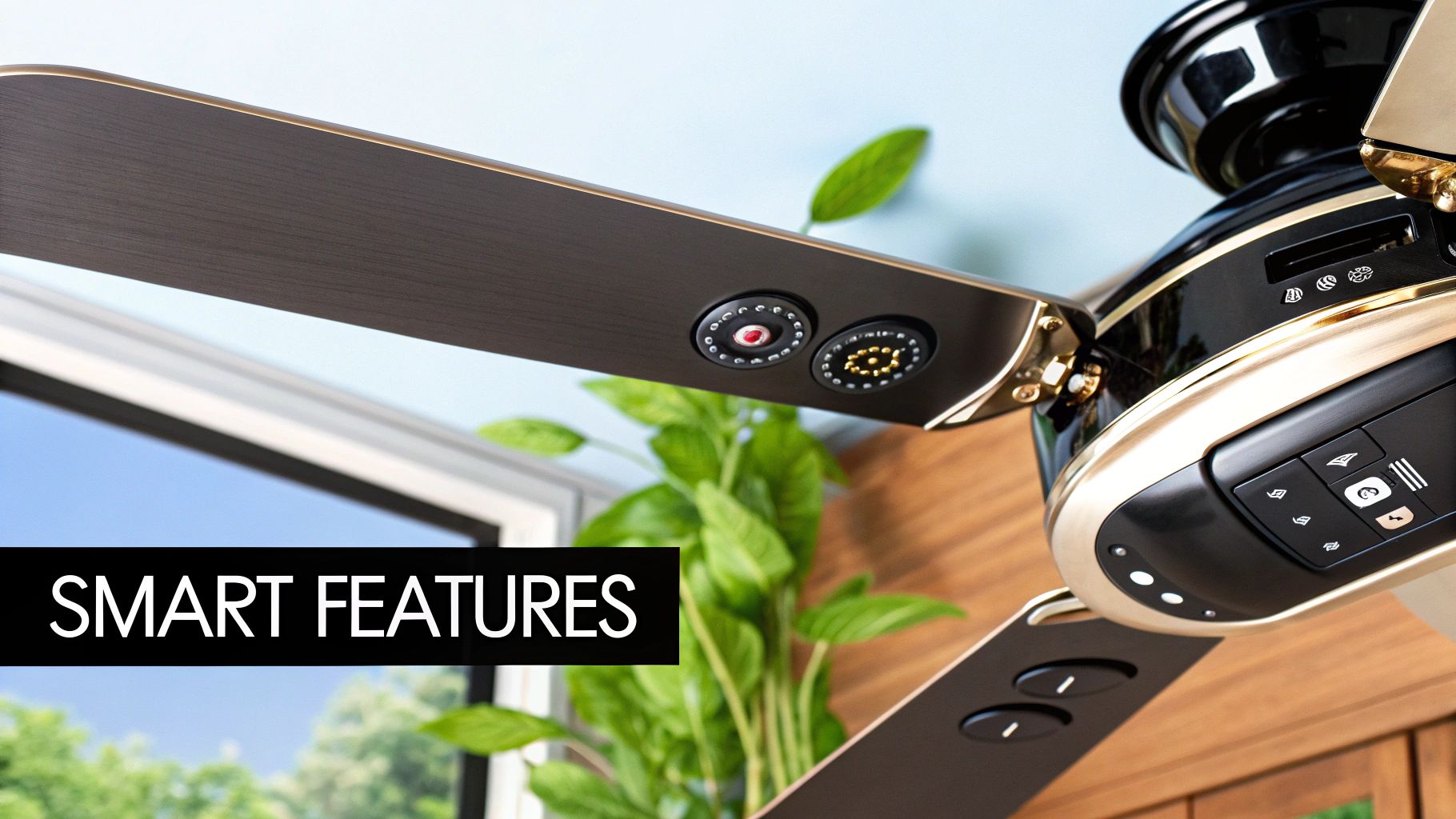
Where you put your fly fan is just as important as which one you buy. Think of it as a personal bodyguard for your food, not a bug zapper for the whole yard. Strategic placement turns your outdoor table from a fly free-for-all into a pest-free bubble.
The golden rule is simple: place the fan as close to the food as possible. Its power comes from disrupting the air and light directly over your plates and serving dishes. If it's too far away, the effect is diluted, and determined flies will find their way through.
This targeted approach is a huge reason these fans are so popular. People are actively seeking safer pest control, which has helped the global insect repellent market grow to an estimated USD 5.7 billion in 2024. As more of us look for effective, chemical-free ways to keep bugs away, devices that offer precise protection are becoming the go-to solution. You can dig into more data on this impressive market growth over on GlobeNewswire.
Scaling Your Setup for Any Table
How many fans do you need? It depends on the size of your table and food spread. A one-size-fits-all approach doesn't work. The goal is to create overlapping zones of protection with no weak spots.
Here’s a simple guide:
- Small, Round Tables (2-4 people): One fan in the middle is usually enough. It creates a protective dome that covers everyone's meal.
- Standard Rectangular Tables (6-8 people): Use two fans. Place one at each end of the table to generate a continuous barrier down the center.
- Long Buffet Lines or Large Party Tables: Deploy multiple fans. A good rule of thumb is one fan every 3-4 feet to ensure the entire food spread is protected.
Don't be afraid to adjust the fans on the fly. If you see a pest testing the defenses near a certain dish, just nudge the closest fan to shore up that spot. It’s all about actively managing your fly-free space.
Common Placement Mistakes to Avoid
Even the best fly fan won't work if it's set up wrong. Steer clear of these common mistakes for the best performance.
1. Placing Fans Too High: Height is everything. Putting a fan on a high shelf or hanging it far above the table is a classic mistake. The air currents need to be at food level to disrupt a fly’s flight path.
2. Obstructing the Blades: Make sure a tall centerpiece or a bottle of wine isn't blocking the fan blades. The fan needs clear, open space to spin freely and create its protective airflow.
Once you master these simple placement strategies, your fan becomes your most powerful tool for a peaceful, pest-free meal.
Real-World Uses: From Patios to Parties
Seeing a fly repellent fan in action is what makes its value click. It can transform a frustrating, swat-filled meal into a relaxing one. Their versatility makes them a quiet hero in all kinds of situations, from a casual family dinner to a large event where hygiene is critical.
Imagine a simple weeknight dinner on your back patio. The burgers are hot off the grill, but so are the flies. Placing just one of these fans in the middle of the table creates an instant sanctuary. Your family can enjoy their meal without that constant, irritating buzz. The same idea works for weekend barbecues—a couple of fans can guard the main dining table and the serving area.
Elevating the Customer Experience
For restaurants and cafes, the stakes are much higher. A single fly can ruin an outdoor dining experience and lead to a bad review. For any business with a patio, placing a fan on each table is a game-changer.
It’s a small, elegant touch that shows guests you care about their comfort and cleanliness. This simple addition creates a better atmosphere, encourages people to stay longer, and protects your reputation. The fan works silently in the background, ensuring customers focus on the great food and conversation.
The fan doesn't just repel flies; it elevates the entire guest experience. In a competitive market, these small details build loyalty and generate positive word-of-mouth.
An Essential for Large-Scale Events
Now, let's scale up to a big outdoor wedding reception or a crowded food festival. Here, guest comfort and food safety are non-negotiable. The fly repellent fan becomes an indispensable tool. Caterers can line their buffet tables with a series of fans, creating a continuous, invisible barrier that keeps the spread sanitary and appealing all day long.
Food vendors at festivals can use them to protect their stalls, creating a clean, inviting space that draws in customers. It’s a simple and scalable solution for any occasion where food is served outside. If you want more strategies for safeguarding your food, check out our detailed guide on how to keep flies away from food.
Simple Maintenance for Lasting Performance

To keep your off-repellent fan working perfectly season after season, a little care goes a long way. A few simple checks ensure it works reliably when you need it most. With just a few minutes of attention, you can keep the blades effective and the motor running smoothly.
The most important task is keeping the holographic blades clean. Over time, dust, pollen, and fingerprints can dull their reflective surface. This weakens the visual trick that confuses flies, so a gentle wipe-down is all it takes to restore their power.
Cleaning and Battery Care
Keeping your fan in top shape is easy. Just follow these simple steps:
- Wipe Blades Gently: Use a soft, dry microfiber cloth to wipe the blades. Avoid abrasive cleaners or rough paper towels, as they could scratch the holographic pattern.
- Check Batteries Regularly: If the fan slows down, it’s time for fresh batteries. When the rotation weakens, the airflow drops, making the fan less effective.
- Store Properly Off-Season: When you pack the fan away, always remove the batteries. This simple step prevents corrosion and damage to the internal parts, ensuring it's ready for your next outdoor gathering.
This hassle-free upkeep is a big reason these devices are so popular. The portable fan market was valued at around USD 456 million in 2022 and continues to grow as people look for convenient, effective ways to stay comfortable outside. If you're interested, you can dive deeper into the personal portable fan market research to see how innovations are shaping the industry.
Still Have Questions? Let's Clear Things Up
Even after seeing how these fans work, you might have a few questions. That's normal. Let’s tackle the most common ones so you can decide if this gadget is the right fit for your next gathering.
Here are the essential details on safety, coverage, and what they can (and can't) do.
Are These Fans Actually Safe Around Kids and Pets?
Absolutely. This is their biggest selling point for families. Well-made repellent fans are built with soft-stop technology. The blades are soft and flexible, and they're designed to stop instantly at the slightest touch.
If a curious child's hand or a playful pet's nose gets in the way, the blades simply stop. No harm done. This feature makes them one of the safest pest solutions you can put right in the middle of a dinner table.
At their core, these fans are designed for peace of mind. You're not dealing with chemical sprays, hot zappers, or anything that could cause harm. It's just a gentle, physical barrier, which is why they're perfect for family-focused events.
How Much Area Does One Fan Actually Cover?
Think of a single fan as creating a protective bubble with a radius of about 2 to 3 feet. This is perfect for keeping a standard four-person table clear of flies.
But what about bigger tables or buffet lines? That’s where a little strategy comes in.
- Long Rectangular Tables: You’ll want two fans. Place one at each end to create overlapping zones of protection that guard the entire length.
- Buffet Spreads: Place one fan every 3-4 feet along the line. This creates a continuous, uninterrupted barrier.
Will They Work on Mosquitoes or Bees Too?
This is a big one. These fans are specialists—they’re engineered specifically to deter common houseflies. The holographic patterns on the blades are designed to disrupt a fly's compound eyes, and the air currents are just enough to throw off their flight.
While the breeze might bother a mosquito, it's not a reliable repellent for them. As for bees and wasps, they navigate differently and aren't fazed by the reflective blades, so the fans have little to no effect on them.
Ready to enjoy a meal outdoors without the constant swatting? Check out the elegant and effective solutions from MODERN LYFE to find the perfect fly fan for your home, restaurant, or next event. Visit us at https://modernlyfe.com and take back your outdoor space.

